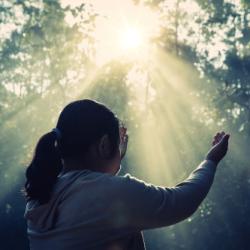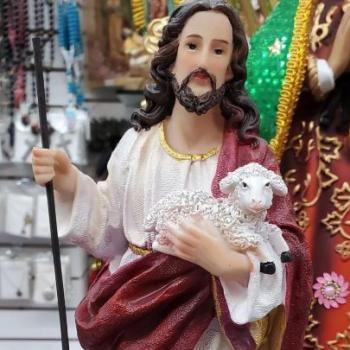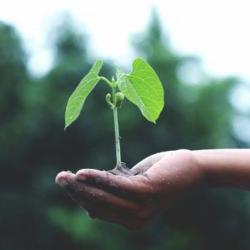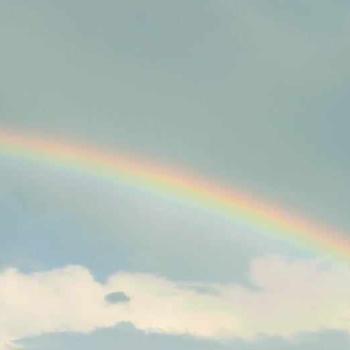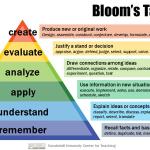The archetypal story of Noah and the Ark has become a beloved children’s motif. But it takes on heavier significance when read in light of our climate crisis and the floods of global warming. How should the Church respond to the threats of climate change?
[Biblical text: Genesis Chapters 6 – 9]
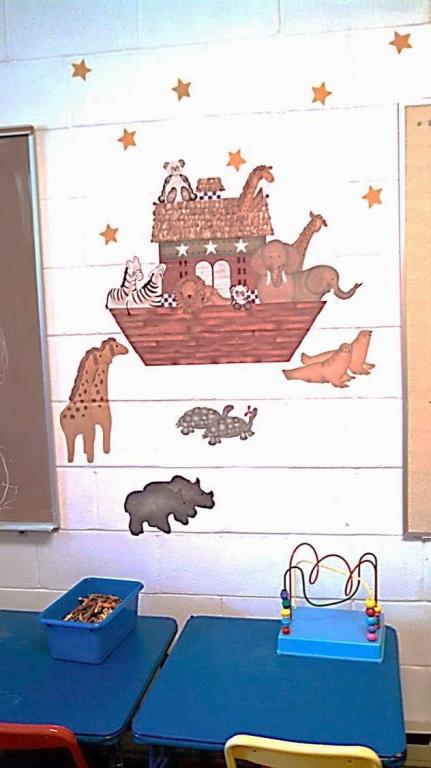
The wall of the children’s nursery in my previous church had a painting of Noah’s Ark.
Kids love the image of all the animals floating together in a big sea-going zoo. I remember shopping for baby items for my children and seeing cute renditions of the ark with adorable giraffes, hippos, and horsies poking their heads out of the windows and smiling from the deck.
But the story is really quite a tragedy, as the movie Noah starring Russell Crowe, has portrayed. If you really think about it, the cataclysmic destruction of life on Earth is overwhelming. And despite our efforts to soften the story, children can still grasp the enormity of the loss. I remember talking about Noah’s Ark in a children’s sermon once, and one child asked, “What happened to all the other animals who weren’t on the ark? And the people?” Er, uh . . .
We rush to the iconic dove and rainbow — God’s promise to never again destroy the Earth. But the truth is, the planet suffered immense loss in that primordial flood.
Here’s the truth, child. When human beings fill the earth with violence, everyone suffers. Even the animals. When human hearts are corrupt and filled with evil, the consequences for the innocent are unbearable (Genesis 6:5 – 13). Yes, the animals died. Yes, the people died. And it’s okay to be sad about that. Because it’s not fair, and it’s not right.
Ancient myths of the flood
Interestingly, the biblical references to a great flood and giant ark have remarkable parallels in many other archetypal myths found around the world. The Noah story as told in the Old Testament is actually a reworking of an earlier Babylonian myth recorded in the Gilgamesh Epic. The stories are nearly identical, save for the names of the characters. And in Greek mythology, there is a story of a eerily similar cataclysmic event in which a hero like Noah builds a boat to survive a great flood. In fact, more than 500 deluge legends are known around the world on nearly every continent.
Why are there so many flood stories? With so much similarity, historians have concluded that there must have been some global cataclysmic event very early in human history, maybe as early as 9500 BCE.
There are different theories as to what caused this global catastrophe. Some geologists think there may have been a huge shift in the earth’s tectonic plates, causing devastating flooding. Others posit that a meteor impacted the earth resulting in earthquakes, volcanic activity and abrupt climate change. But whatever the reason, there is little doubt that the Earth was covered by a deluge that wiped out civilizations around the world, leaving only a remnant of humanity behind to survive, rebuild, and repopulate.
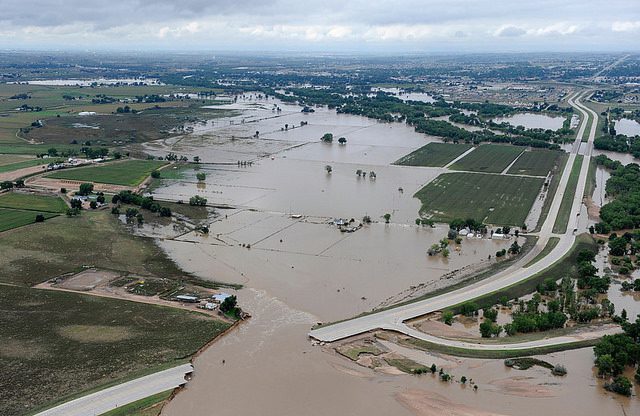
I sometimes wonder if we are living in what will become a future generation’s mythic saga of our planetary catastrophe.
Nearly all my life I have been aware of (and contributing to) the slow-motion rise of a flood that began at the onset of the Industrial Age. From the time I was a child in the 70’s, I had heard warnings about what carbon dioxide from fossil fuels was doing to the atmosphere, warming the planet, melting glaciers, and wreaking environmental havoc across the Earth. Ever since I became a pastor, I’ve advocated for Creation-care, hoping and praying that hearts and minds would open and change. Now here I am with my own children, and The Washington Post reports that a group of scientists, policymakers and corporate leaders have determined that we have a mere three years to set greenhouse gas emissions on a downward path. Otherwise it will become “impossible to contain climate change within safe limits.”
Children are aware of this dystopian future.
At Thanksgiving dinner a few years ago, we were talking about world events and politics when my then 11-year-old daughter piped up, “I don’t know why you’re talking about all this. None of it is going to matter. The apocalypse is already happening. The end of the world is coming.”
Forks clattered. Mouths stood agape with half-swallowed mashed potatoes. All eyes turned to me, the ecofeminist-climate-activist mom. I shrunk in my chair. I never actually used the word “apocalypse” when explaining climate change to her. How did she come up with that?
“Why are you looking at her?” my daughter asked. “Don’t you read the news? It’s not her fault. She’s just trying to warn us.”
Did God try to warn others before getting to Noah?
Had others been given the divine warning about the impending global disaster and refused to heed the call to prepare? We know Noah’s urgent pleas to his neighbors were laughed off as the crazy doomsday scare tactics of a lunatic. In the same way, the warnings of climate scientists today are often dismissed, ridiculed, mocked and silenced. But they are not giving up. “The whole purpose of this comment … is to wake up the intentionality and the ingenuity that we must bring to this effort, because of the urgency,” said Christiana Figueres, who oversaw the United Nations negotiations that produced the Paris climate agreement, and helped author the statement about the three-year window.
But with an all-out assault on the climate and environmental protections by the most powerful nation on Earth, the window of opportunity seems to be narrowing even further.
It’s no wonder that real-life replicas of Noah’s Ark are being constructed around the world (including one near where I live in Kentucky). The ones who build such tourist attractions most likely would deny climate change (or insist that God would never let such a global catastrophe destroy the earth).
But it makes me wonder if the ark-archetype is gaining traction at some level of human consciousness. Because whether we admit it or not, we know the waters are on the rise.
Of course the logistics of getting all those species on a single seafaring vessel is quite absurd and impossible. Just think about how many living creatures Noah would have had to collect and fit on that ark. Here’s a list:
7000 species of worms
50,000 species of arachnids
900,000 species of insects
2500 species of amphibians
6000 species of reptiles
8600 species of birds
and 3500 species of mammals
plus food for one and all. (Walker, Symbols, 85).
How big would that boat have to be?
Here’s the thing: “The only vessel truly capable of holding all these is Spaceship Earth,” (Walker, Symbols, 85).
But this fragile planetary vessel floating in a sea of darkness and stars has once again been filled with with violence. We are finding ourselves with Noah in a Genesis 6 moment. Too many human hearts are corrupt and filled with evil, and the consequences for the innocent are unbearable.
Because it’s not just the climate crisis that plagues this earth. It is a convergence of global crises swirling into a perfect storm on the horizon. The cost of our primary source of energy – fossil fuels – is poisoning water, land, sky and bodies. The explosion of the human population is about to reach unsustainable levels. Financial crises have swept across our human society. And, yes, ecological issues regarding water supplies, global warming, garbage and pollution are threatening the health of the planet itself.
Add to this the accompanying threats of terrorism and war as a result of these conflicts over land and resources (and exacerbated by climate change) and we are, once again, facing a flood of catastrophic proportions. A flood of people, a flood of poverty, a flood of violence, and yes, the actual flooding of the coastlands and river around the world.
But this time the flood is not coming from God. It’s coming from humankind.
It’s hard not to see Noah’s story as a future-present allegory for our own time. In Genesis, God promised to never again destroy the Earth (Genesis 9:8-17). But human beings apparently are not willing to make that same promise. When we put country over planet, when we value our current comfort over our children’s survival, it appears some fatal genetic flaw was passed to us from Adam and Eve through Noah. He and his family were, after all, descendants of the first humans who took what they wanted, despite divine warnings of dire consequences.
What does this mean for us? And what are the implications for the Church in the decades ahead?
In her excellent book Living Beyond the End of the World, Margaret Swedish minces no words: “Nothing will make this wrenching transition go away; we can neither avoid it nor escape it. We have nowhere to go. We will either find a way to live through it, with dignity, with integrity, with hope (not optimism), or we will go through it with mounting human suffering. . . We are coming to the end of the world, or at least to the end of a world. How it ends will be very much up to us. We have many choices in front of us, but not this one – that the world we know is ending,” (156, 158).
There will be drastic changes in how we live, and what we do to survive. And for many people, it will be a matter of survival. In fact, for a large portion of the world’s people, it already is a question of basic survival.
The Church, then, must serve as a kind of “ark,” not just for humanity, but for all Creation. Comparisons of the Church to Noah’s Ark have been made since 1 Peter 3:13-22 (and for an excellent treatment of this text, see this Journey with Jesus essay). But it’s past time for Christians to advocate for all species of plants and animals, as well as the most vulnerable human communities, to find refuge on this ark of planet Earth.
Thankfully, more and more followers of Jesus and other faith communities are making Creation-care a priority.
An increasing number of religious communities are “going green,” as they come to view ecological issues as a matter of justice for the poor, and for the voiceless among God’s creatures (visit GreenFaith for more info). Nine different denominations have moved to divest from fossil fuels. And my ecotheology colleague, Jim Antal, authored a resolution recently approved by the United Church of Christ to denounce President Trump’s withdrawing the US from the Paris climate accords. [For a list of what different faiths have done to advocate for environmental issues, visit Yale’s Forum for Religion and Ecology.]
Disaster response
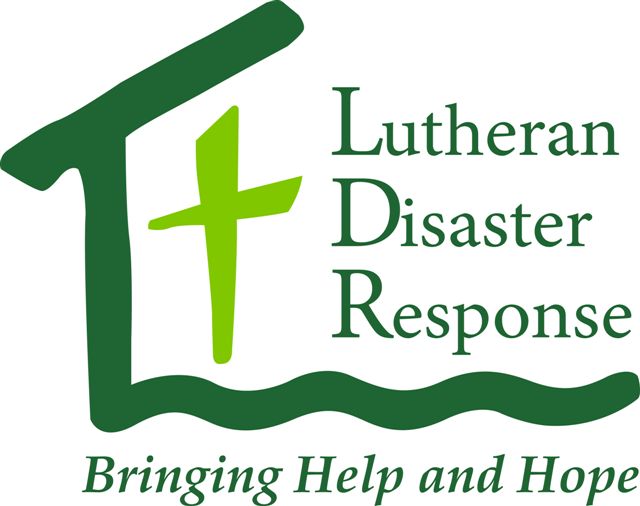
In terms of more immediate danger, there is also the urgency among religious communities to be prepared for climate-related disasters when they happen. My own Lutheran denomination (ELCA) has an entire division devoted to this effort called Lutheran Disaster Response. What’s great about LDR is that not only do they arrive on the scene when disasters hit, but they stay with communities long after the media spotlight has moved on. They remain committed to the people and neighborhoods in need of help until they have restored their lives and communities. As we’re seeing increasing numbers of climate-exacerbated weather catastrophes, LDR and other church emergency agencies will be needed more and more.
When there are weather-related events, the ark of the Church must be there to assist people, restore some sense of sanity, provide aid and relief, and help to rebuild. We’ve seen that happen over and over again, whether they are tsunami victims in southeast Asia, drought vicitms in Africa, flood victims in New Orleans and along the Mississipi, or victims of the steady onslaught of hurricanes each year. The ark of the Church is there for them, sending forth the dove of peace, and pointing to the rainbow overhead promising God’s ever-present care.
The hardest thing we have ever done
But people of faith must also add their voices and votes to the calls for immediate changes in our energy policies, meat consumption, and carbon-burning lifestyles and industries that are causing the flood of injustice and poverty to rise at unprecedented rates. Faith leaders in wealthy countries need to model a “downwardly mobile” lifestyle that constrains consumption and restores balance with the ecological systems that support human life. Margaret Swedish describes the challenge this way:
What is required now, and this must be the content of the call, is that this nation and other rich countries – and our religious and pastoral leaders as well – be summoned to turn toward a new way of life, one that puts our consumption and waste back into balance with nature, into a relationship with the earth that allows the earth to heal, restore, regenerate what is needed to continue the story of life, while at the same time making it possible for poor people to no longer be poor. . . This will be the hardest thing we have ever done (171).
We can. We must.
We’re in the hot, crowded ark. The flood waters are rising. We must ask ourselves: What kind of Church will we be? What kind of person am I being called to be?
As I remind my children every time we see a rainbow: God has promised to be with us, no matter what we face, and even if it is by our own hand. That promise is refracted by millions upon millions of tiny prism droplets in the sky, forming the colors of the rainbow that fill us with hope.
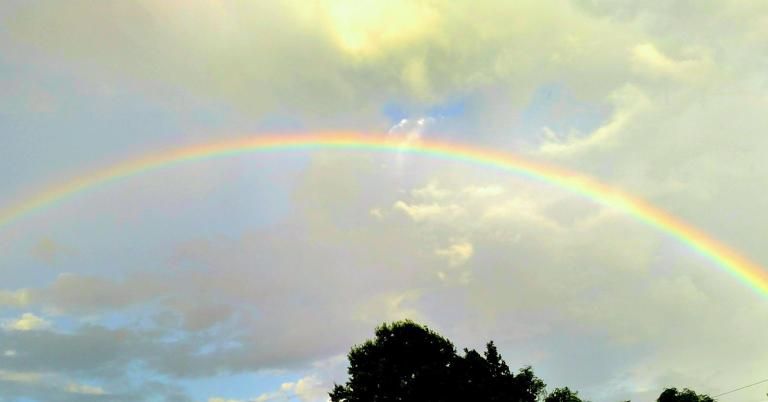
Leah D. Schade is the Assistant Professor of Preaching and Worship at Lexington Theological Seminary (Kentucky) and author of the book Creation-Crisis Preaching: Ecology, Theology, and the Pulpit (Chalice Press, 2015).
Leah will be presenting at the Wild Goose Festival in Hot Spring, NC, July 14 and 15! Her session info is available here: http://wildgoosefestival.org/sessions17-24/. Enter the special code BEMYGUEST for a 25% discount on tickets!
You can follow Leah on Twitter at @LeahSchade, and on Facebook at https://www.facebook.com/LeahDSchade/.
Check out Leah’s other posts on climate change:
What Can a Person of Faith Do About Climate Change?
Exit Paris? Enter Pentecost! A Christian Response to Reneging on the Climate Promise
Climate Change Impacts Health, Families, and Wallets
Why Changing Light Bulbs May be Hurting the Climate Movement
Sources:
Mooney, Chris, “These experts say we have three years to get climate change under control. And they’re the optimists,” The Washington Post, June 29, 2017. https://www.washingtonpost.com/news/energy-environment/wp/2017/06/29/these-experts-say-we-have-until-2020-to-get-climate-change-under-control-and-theyre-the-optimists/?utm_term=.4fe8d254e29b.
Swedish, Margaret, Living Beyond the End of the World: A Spirituality of Hope. Orbis, 2008.
Walker, Barbara G., The Woman’s Dictionary of Symbols and Sacred Objects, HarperSanFrancisco, 1988.








